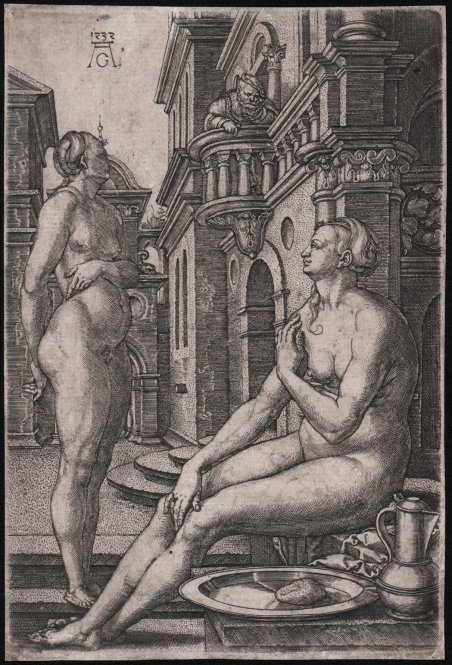Betsabea al bagno, seduta in primo piano a destra e un'altra figura femminile nuda, in piedi, accanto a lei nel cortile. Davide la guarda da un balcone dell'edificio, a destra. Bulino, 1532, firmato con monogramma e datato in alto a sinistra. Esemplare nel secondo stato di tre. La vicenda è narrata nella Bibbia, nel Secondo Libro di Samuele. Davide, benedetto Re d’Israele dal sacerdote e profeta Samuele, mentre i suoi soldati sono impegnati a devastare il paese degli Ammoniti ed a porre l’assedio ad una città, rimasto nel suo palazzo a Gerusalemme, dalla terrazza vede la figlia di Eliam, Betsabea, che fa il bagno. Davide incantato dalla sua bellezza e sconvolto dal desiderio, pur sapendo che lei è la moglie di Uria, uno dei suoi più valorosi comandanti, la convoca ed ha con lei un rapporto carnale. Poco prima del 1520, alcuni giovani artisti della cerchia di Albercht Dürer presero a realizzare incisioni molto piccole che hanno sfidato lo spettatore con un mondo in miniatura, un mondo di nuovo soggetto laico e di interpretazioni non convenzionali di temi tradizionali. A causa delle ridotte dimensioni delle loro incisioni, questi artisti sono stati appellati a lungo, con il nome collettivo, e poco lusinghiero, di Piccoli Maestri di Norimberga. Il nucleo del gruppo consiste in tre artisti di Norimberga, Hans Sebald & Bartel Beham e Georg Pencz, e inoltre Jacob Bink da Colonia e Heinrich Aldegrever da Soest. Bellissima prova, impressa su carta vergata coeva con filigrana "unicorno" (simile a Piccard 3144, che la data al 1535), con sottili margini o rifilata al rame, minimi restauri agli angoli inferiore e al superiore sinistro, per il resto in ottimo stato di conservazione. Bibliografia New Hollstein (German), The New Hollstein: German engravings, etchings and woodcuts 1400-1700 (37.II); Bartsch; Le Peintre graveur (VIII.373.37). David and Bathsheba; Bathsheba at the bath, seated in right foreground; another nude female figure standing next to her in the court-yard at left; David looking on from a balcony of the building at right. Engraving, 1532, signed with monogram and dated at upper left. The story is told in the Bible, in the Second Book of Samuel. David, blessed King of Israel by the priest and prophet Samuel, while his soldiers are busy ravaging the land of the Ammonites and laying siege to a city, remaining in his palace in Jerusalem, from the terrace sees Bathsheba, the daughter of Eliam, bathing. David enchanted by her beauty and distraught with desire, though he knows that she is the wife of Uriah, one of his most valiant commanders, summons her and has carnal intercourse with her. Shortly before 1520, some young artists in Albercht Dürer's circle took to making very small engravings that challenged the viewer with a miniature world of new secular subject matter and unconventional interpretations of traditional themes. Because of the small size of their engravings, these artists have long been affixed with the collective, and unflattering, name of Small Nuremberg Masters. The core of the group consists of three artists from Nuremberg, Hans Sebald & Bartel Beham and Georg Pencz, and in addition Jacob Bink from Cologne and Heinrich Aldegrever from Soest. Example in the second state of three. Beautiful proof, printed on contemporary laid paper with "unicorn" watermark (similar to Piccard 3144, which dates it to 1535), with thin margins or trimmed to copper, minimal restorations to lower corner and upper left corner, otherwise in excellent condition. Bibliografia New Hollstein (German), The New Hollstein: German engravings, etchings and woodcuts 1400-1700 (37.II); Bartsch; Le Peintre graveur (VIII.373.37). Cfr.

Scopri come utilizzare
Scopri come utilizzare

